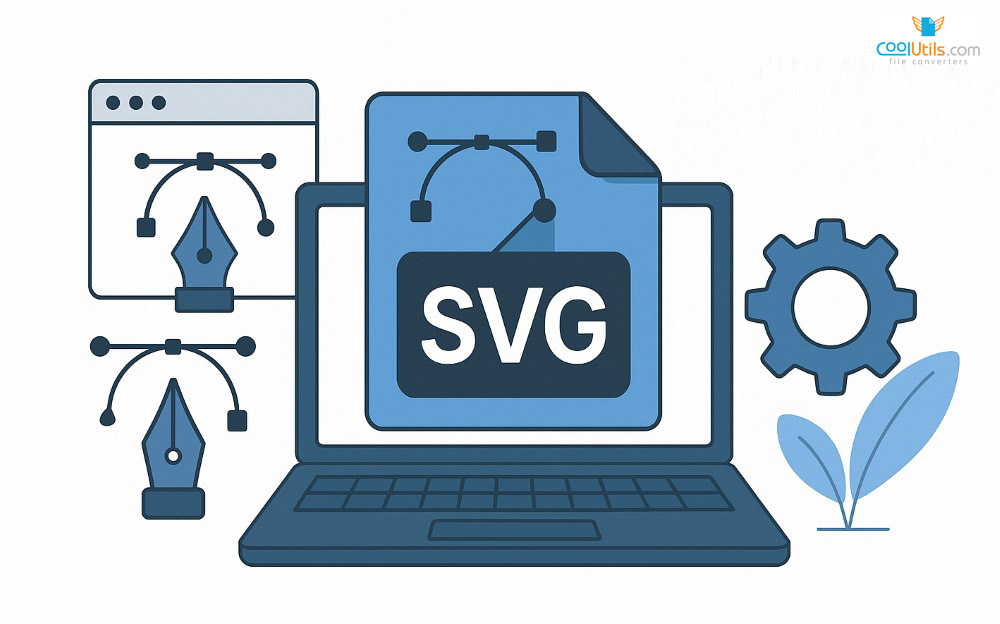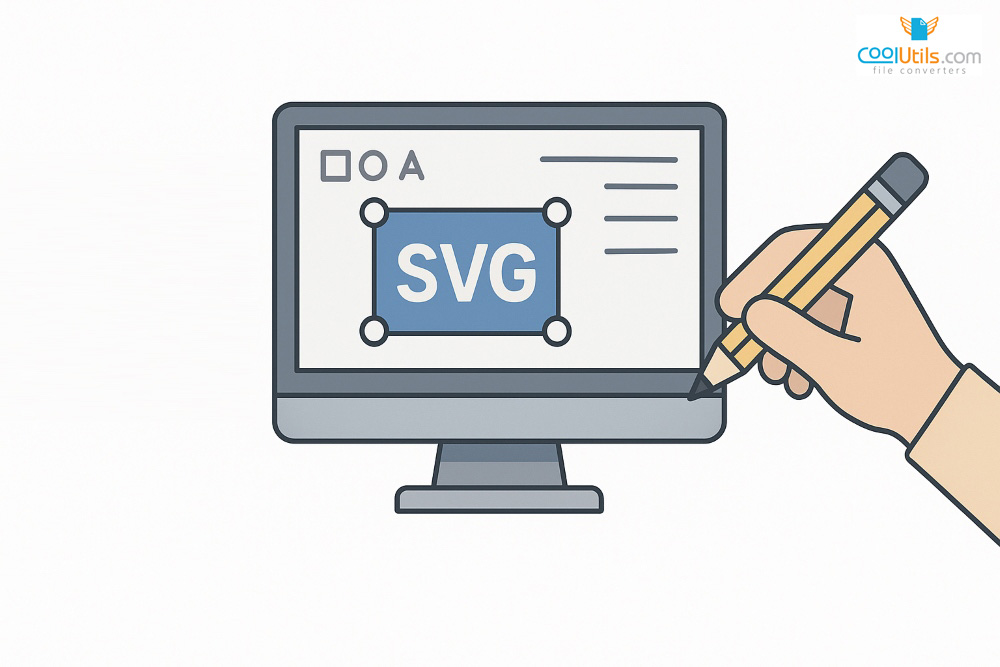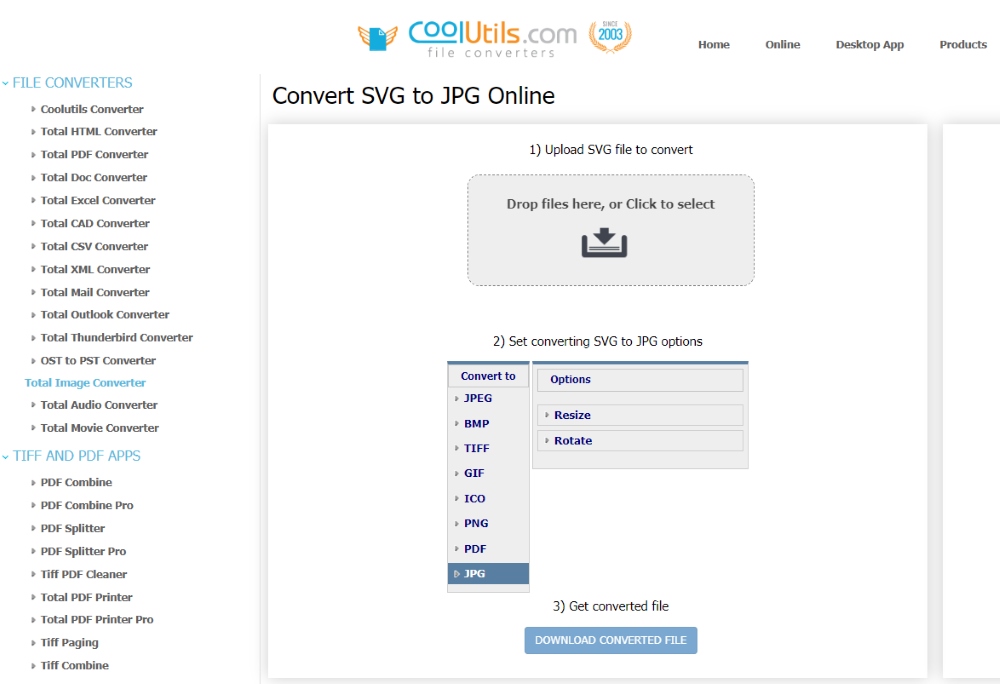
What Is SVG File Format: Complete Guide and Tutorial
Ever encountered SVG files while working with web graphics and wondered what makes them special? These files represent a revolutionary approach to digital graphics, offering infinite scalability without quality loss. Unlike traditional raster images that become pixelated when enlarged, the format maintains crisp, professional appearance at any size. This comprehensive guide explores everything you need to know about the format, helping you harness the power of scalable vector graphics for your digital projects.
Key takeaways
- Vector files use mathematical formulas instead of pixels, enabling infinite scaling without losing image quality, making them perfect for responsive web design across all device sizes.
- Scalable vector graphics excel in web performance with smaller file sizes than equivalent raster images, while supporting advanced features like CSS styling, JavaScript interactivity, and search engine indexing.
- SVG graphics offer superior accessibility through screen readers and enhanced SEO benefits via indexable text content, unlike bitmap images that store text as visual elements.
- Modern web browsers provide native support for the format, allowing direct viewing, editing, and integration with HTML, CSS, and JavaScript for dynamic web experiences.
What is an SVG?
SVG stands for scalable vector graphics, representing a fundamental shift from traditional pixel-based formats like JPEG, PNG, and GIF files. Unlike raster images composed of fixed grids of colored pixels, the format stores visual information through XML code that defines mathematical formulas for shapes, lines, and points on a coordinate system. This vector-based approach allows infinite scaling without degradation, maintaining perfect clarity whether displayed on small smartphone screens or large desktop monitors.
The SVG file format differs dramatically from bitmap images in its core architecture. While raster formats record individual pixel information, vector graphics use mathematical descriptions to define geometric elements. When you resize an SVG image, the browser recalculates these mathematical relationships, ensuring crisp rendering at any dimension. This makes the format ideal for responsive web design, where graphics must adapt seamlessly across various device sizes.
One significant advantage lies in their XML-based structure, which stores textual content as actual text rather than visual shapes. This characteristic enables search engines to read and index content for keywords, potentially improving website search rankings. The XML markup also allows developers to modify elements using CSS and JavaScript, creating dynamic graphics that respond to user interactions, hover effects, and real-time data changes. Additionally, they support accessibility features like alt text and title attributes, making them compliant with modern web standards. You can easily identify SVG files by their distinctive .SVG extension.
The Nature of Vector Images in SVG Format
The fundamental distinction of SVG files lies in their use of mathematical formulas rather than pixels to define visual elements. Each component within the graphics, from simple lines and curves to complex shapes, is mathematically described through precise equations that specify coordinates, dimensions, and styling properties. This mathematical foundation enables perfect scaling regardless of zoom level or display requirements, making SVG images incredibly adaptable across different viewing contexts.
Vector graphics excel particularly for images with defined borders and clean lines, where mathematical precision translates into superior visual quality. Whether viewed on a tiny smartphone display or massive desktop monitor, SVG files maintain their crisp appearance through real-time mathematical calculations.
A Brief History of SVG Files
The format traces its origins to 1994 when Dutch engineer Martijn Koster first conceptualized scalable vector graphics. The World Wide Web Consortium (W3C) later invited proposals from developers in the late 1990s, seeking a new vector graphic format suitable for web applications. The W3C finalized SVG files as an ISO standard in 2003, positioning them as a modern alternative to raster formats. However, adoption took considerable time, primarily due to limited browser support. The format truly flourished around 2017, when modern web browsers began offering comprehensive native support for SVG files.
What are SVG Files Used For?
SVG files serve multiple applications that showcase their versatility in modern digital design:
- Responsive web design – SVG graphics ensure sharp display across diverse device sizes, from smartphones to desktop monitors
- Web and application icons – crisp rendering at various sizes throughout user interfaces
- Company logos – maintaining professional appearance from small headers to large marketing materials
- Data visualizations and infographics – supporting interactivity and dynamic content updates
- Artistic illustrations – resolution-independent visuals with advanced capabilities like gradients and patterns
Pros and Cons of SVG Files
Understanding advantages and disadvantages proves essential before implementing this file format in your projects.
Advantages of SVG Files
SVG files offer compelling advantages for modern web development:
- Resolution independence – perfect quality at any size, unlike pixel-based formats that degrade when scaled
- Smaller file sizes – mathematical algorithms require less storage than individual pixel data
- Animation capabilities – CSS or JavaScript animations for dynamic user experiences, including animated SVG elements
- Easy editing – vector programs like Adobe Illustrator or text editors for modifications
- Accessibility and SEO – text readable by screen readers and indexable by search engines
- Browser compatibility – native support across all major browsers
Disadvantages of SVG Files
SVG files present notable limitations:
- Older browser support – Internet Explorer 8 and earlier versions lack complete support for the format
- Complexity – steeper learning curve compared to JPEG and PNG formats
- Poor for photographs – unsuitable for realistic images with subtle color gradations
- Small size display issues – may appear inconsistent at very small dimensions
How to Open SVG Files
Opening the format requires no specialized software, as modern web browsers including Chrome, Edge, Safari, and Firefox provide native support for viewing graphics directly. Simply drag and drop the file into your browser window or use File > Open menu to view SVG files immediately.
For advanced editing, professional vector graphics applications offer comprehensive support to edit SVG files: Adobe Illustrator, Adobe Photoshop, Inkscape, and Affinity Designer. Text editors can also access the underlying XML code for manual modifications, allowing users to view SVG files as source code and work with SVG image content directly.
How to Upload SVG to WordPress
WordPress blocks SVG file uploads by default due to security concerns. However, you can safely enable support through two approaches:
Plugin Method:
- Install plugins like SVG Support or Safe SVG plugins that support SVG format
- Automatic sanitization prevents security vulnerabilities
- Seamless integration with WordPress media library
- User-friendly interfaces with advanced features
Manual Method:
- Modify theme’s functions.php file
- Add code snippet to enable uploads
- Greater control over handling
- Eliminates plugin dependencies
Both approaches enable graphics within WordPress while maintaining security standards and proper file handling. This process makes the format accessible for website content and ensures compatibility across different themes.
How to Create and Edit an SVG File
| Software Type | Examples | Best For |
| Professional Vector Apps | Adobe Illustrator, Inkscape, CorelDRAW | Complex graphics, professional work |
| Online Tools | Method Draw, Vectr, Figma | Basic graphics, beginners |
| Raster Editors | Adobe Photoshop | Export only (limited features) |
Adobe Photoshop can export the format through File > Export > Export As, selecting the format option. However, professionals prefer Adobe Illustrator for optimal creation due to its dedicated vector graphics tools. When creating graphics in Illustrator, start by designing your graphic using vector shapes and paths. Avoid raster effects and ensure text is converted to outlines for better compatibility. Export settings should be optimized for web use – select profile, choose “Responsive” for scalable dimensions, and minimize file size by removing unused elements. For complex illustrations, consider grouping related elements and using meaningful IDs for easier CSS styling later.

How to Convert SVG Files to Other Formats
Converting the format to alternative formats becomes necessary when working across different platforms or applications with varying format requirements. Common conversion targets include JPG for universal web compatibility, PNG for transparency with broad compatibility, PDF for document sharing, BMP for uncompressed images, and TIFF for print production workflows.
Professional graphics software provides comprehensive conversion options. Adobe Illustrator and Inkscape offer robust export functions with customizable settings for resolution, color profiles, and compression levels. Online conversion tools like CoolUtils offer convenient alternatives for users seeking quick conversion solutions. Available conversion options include:
- SVG to JPG for universal web compatibility
- SVG to PNG for transparency support
- SVG to PDF for document distribution
- SVG to BMP for uncompressed raster output
- SVG to TIFF for high-quality print production

When converting from vector to raster formats, specify appropriate resolution settings to preserve quality. Remember that this conversion is one-directional – once vector data transforms to pixels, the scalability advantage disappears permanently.
SVG Files vs. Other Formats
| Feature | SVG Files | PNG Format | JPEG |
| Scalability | Infinite without quality loss | Fixed resolution | Fixed resolution |
| File Size | Small for simple graphics | Larger for equivalent images | Smallest for photos |
| Animation Support | CSS/JavaScript animations | No | No |
| Browser Editing | CSS/JavaScript compatible | No | No |
| Search Engine Indexing | Text content indexed | No text indexing | No text indexing |
What’s the difference between SVG, PNG, and JPEG?
SVG files differ fundamentally from PNG and JPEG formats in their underlying technical structure and intended applications. Both JPEG and PNG represent raster graphics composed of fixed pixel grids, making them well-suited for photographs and complex images that appear sharp at their intended display size. However, these raster formats suffer from quality degradation when scaled significantly beyond their original dimensions.
Vector graphics use mathematical definitions that enable unlimited scaling without quality loss, making them ideal for responsive design elements that must adapt to various screen sizes. The practical implications become apparent when comparing scalability: raster formats become blurry and pixelated when enlarged substantially, while SVG image maintains crisp definition at any size.
What is the difference between an SVG and EPS file?
SVG files and EPS (Encapsulated PostScript) formats both serve graphics needs but target different applications. The primary distinction lies in their file structure: EPS formats use binary encoding while the format employs XML text, making graphics editable with standard text editors whereas EPS formats require specialized software.
Additionally, EPS formats were designed primarily for print applications, while the format optimizes specifically for web use. This fundamental difference results in significant file size variations, with EPS formats typically consuming much larger storage space than web-efficient vector files.
Are SVG Files Good for Website Speed?
Vector format significantly enhances website performance through multiple optimization mechanisms. The format typically produces smaller file sizes than equivalent PNG format images for simple graphics, as mathematical definitions require less data storage than pixel-by-pixel raster information. In practice, icons can be 50-80% smaller than comparable PNG images, while maintaining perfect quality at any resolution.
Embedding directly into HTML documents reduces server requests, improving loading times. This technique eliminates the need for additional HTTP requests and enables faster page rendering. Optimization techniques include:
- Simplifying structure by removing unnecessary elements
- Using specialized compression tools for optimization
- Enabling GZIP compression for embedded content
SEO and Accessibility Benefits of SVGs
Vector format provides significant advantages for search engine optimization and web accessibility. Search engines can index textual content within graphics, potentially improving website search rankings. However, search engines don’t follow internal links within the format or interpret document structure for indexing.
Screen readers can interpret content when properly structured, making the format superior to other image formats for visually impaired users. By incorporating title elements within graphics, developers provide comprehensive text alternatives enhancing accessibility compliance. However, inline SVG images don’t appear in Google Image Search results – they must be linked externally through IMG tags.
Troubleshooting Common SVG Issues
Vector files present three primary challenges with practical solutions:
- Compatibility issues – solve by declaring proper namespaces and testing across target browsers
- Font inconsistencies – fix by matching font names to CSS or embedding fonts directly in files
- Security risks – mitigate through sanitization plugins or trusted sources only
Conclusion
Vector format represents a powerful solution for modern web design and digital graphics, offering unmatched flexibility, scalability, and performance benefits. Their vector-based architecture ensures crisp display at any size while providing smaller file sizes than equivalent raster images. The format’s compatibility with modern web browsers and integration capabilities with CSS and JavaScript make vector graphics an essential tool for creating distinctive, professional visuals.
FAQs
What is a SVG file used for?
Vector format is used for scalable graphics including logos, icons, illustrations, and web graphics that maintain quality at any size while supporting interactivity and animation.
Is an SVG file the same as a PNG file?
No, SVG and PNG files are fundamentally different. The format scales infinitely without quality loss, while PNG is a raster format with fixed pixels.
What program opens SVG?
Modern web browsers, vector graphics editors like Adobe Illustrator and Inkscape, and basic text editors can open files for viewing and editing purposes.
How do I create an SVG image?
Create SVG images using vector graphics software like Adobe Illustrator, Inkscape, or online tools like Figma, then export in the format for web use.